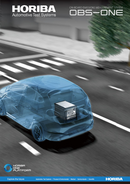

Type approval for LDVs with combustion engines has never been more challenging. In Europe, emissions limits for light passenger and light commercial vehicles are stricter than ever and there is an on-going drive to reduce LDV CO2 emissions plus new/stricter test procedures came into force in 2017. Regarding this last point, type approval requires new car models be subjected to improved laboratory tests - under the EU version of the World Harmonised Light Vehicle Test Procedure (EU-WLTP) – as well on-road Real Driving Emissions (RDE) tests requiring the use of Portable Emissions Measurement Systems (PEMS).
Further regulation changes, and therefore challenges, are on the way. Are you ready?
HORIBA제품의 자세한 정보를 원하시면, 아래의 양식에 내용을 입력을 부탁드립니다.